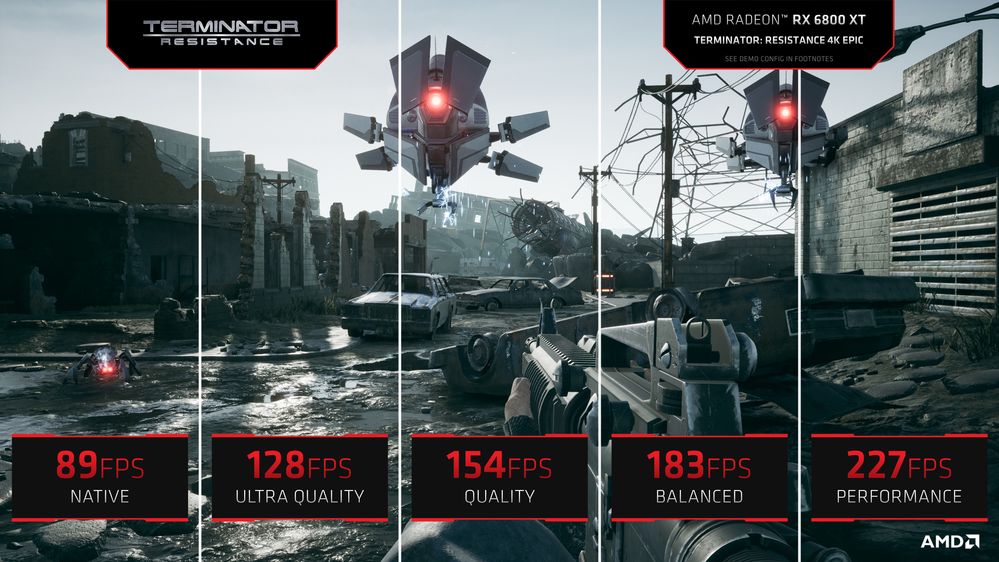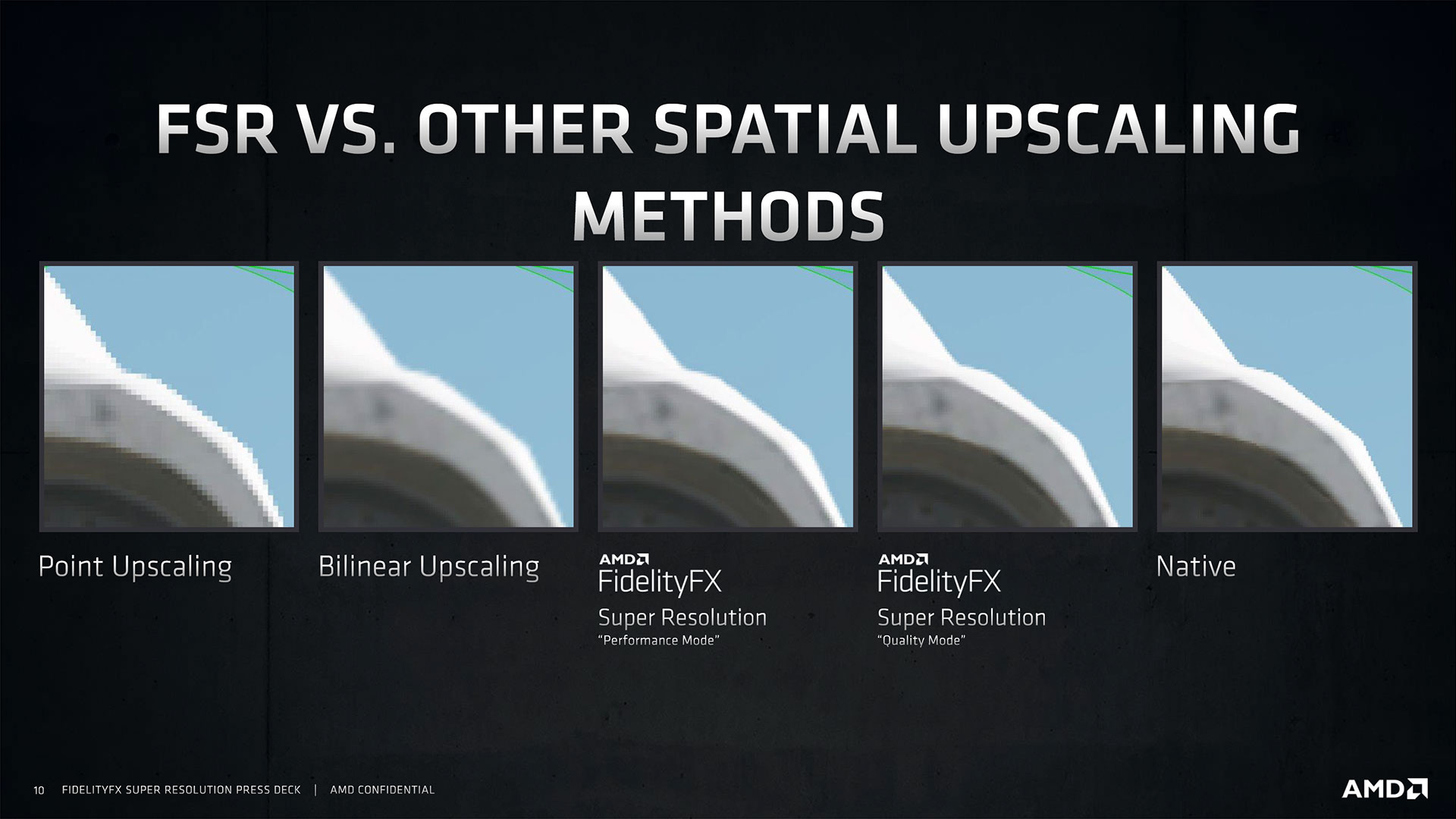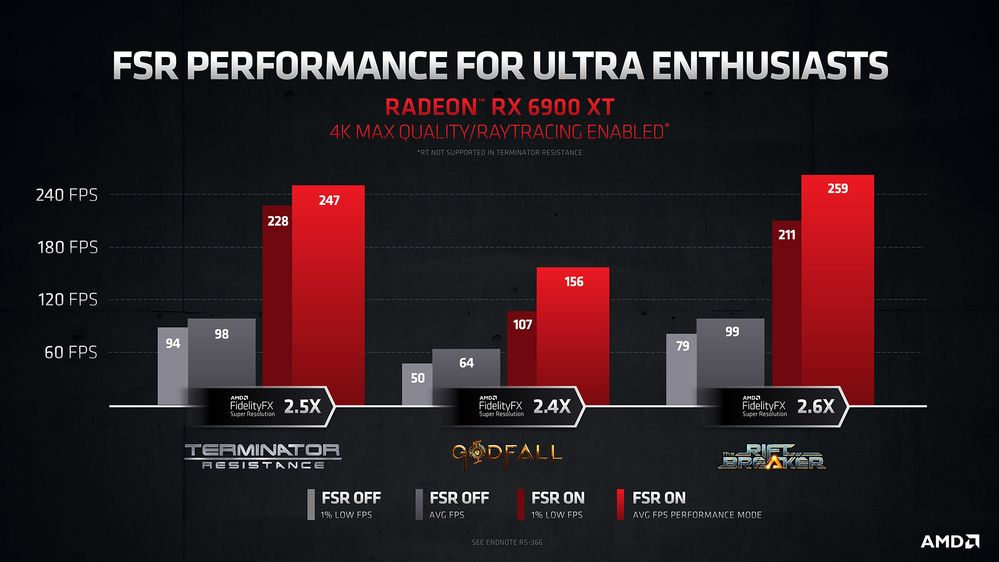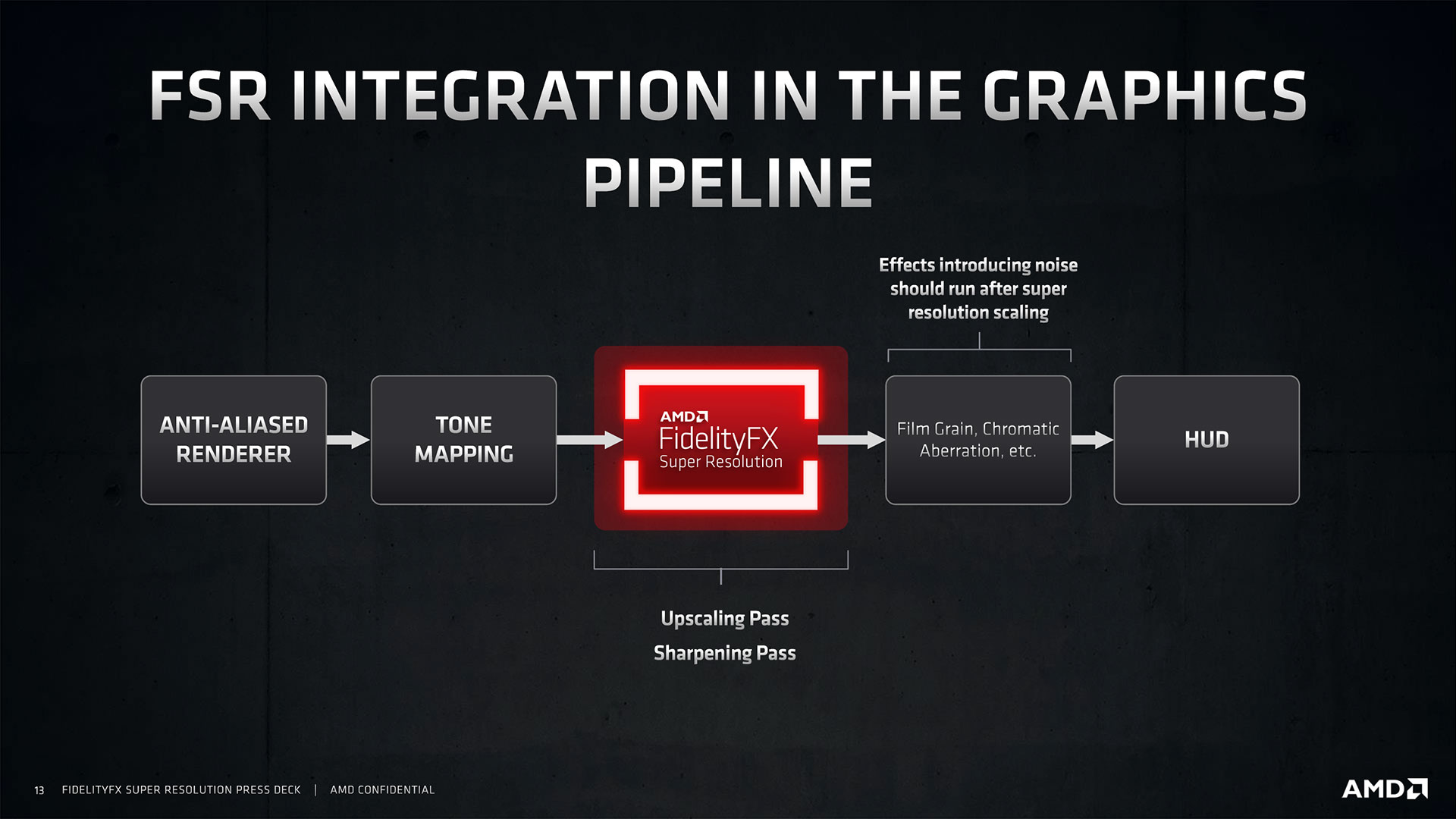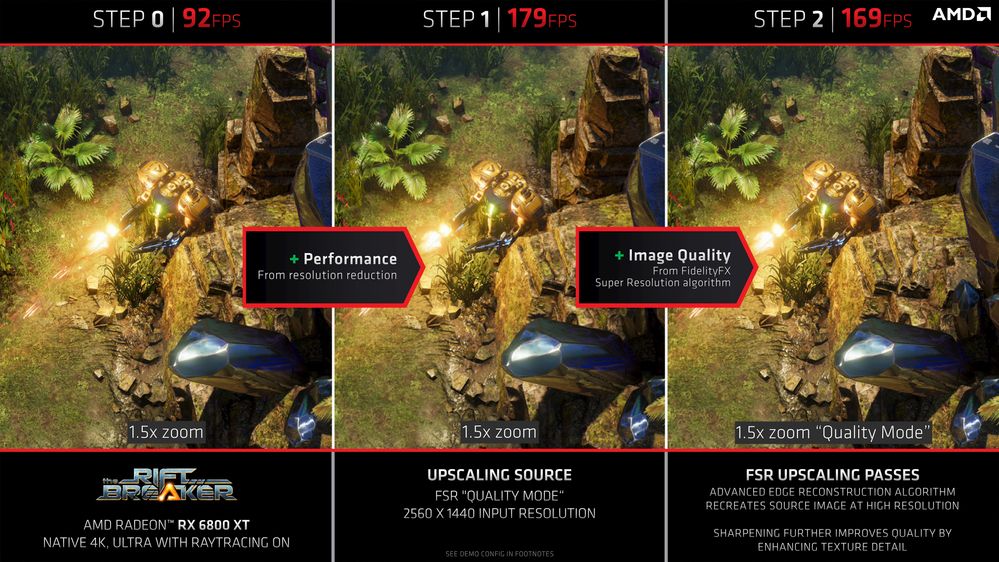What Is AMD FSR? FidelityFX Super Resolution Explained
AMD Fidelity FX Super Resolution (FSR) is a type of rendering technique that looks to boost framerates in games and enable quality high-resolution gaming. It’s also a rival to Nvidia's DLSS, though the two differ quite a bit in how they function. FSR works by rendering frames at a lower resolution and then using an open-source spatial upscaling algorithm to make the game look as though it's running at a higher resolution. DLSS uses an AI algorithm to accomplish similar results, but it only works on Nvidia's RTX GPUs, some of the best graphics cards right now. FSR in contrast will work on just about any GPU — we've confirmed it runs even on Intel integrated graphics, for example.
AMD doesn't directly promote FSR as a competitor for DLSS, mostly because it sees FSR as having application for a wider variety of games. While FSR can definitely help in performance-heavy games and titles with extensive effects, like ray tracing, it can also work as a general purpose algorithm to simply boost performance, even on games that already run fine. That could prove useful for high refresh rate 1440p displays, some of the best gaming monitors, but it can also help smooth out framerates on older GPUs and gaming laptops.
For example, a game might not run particularly well at native 4K rendering. FSR allows a user to render at anywhere from 1440p (FSR Ultra Quality) to 1080p resolution (FSR Performance), which will make hitting higher framerates easier, with two other options as well. The resulting image is then upscaled to the target resolution, resulting in higher performance than 4K and sharper detail than 1080p. UI elements and text are then applied to the final output.
AMD claims that FSR offers an improvement over other types of spatial upscaling methods, like bilinear upscaling. Besides offering different levels of performance and being supported on differing games and apps, the biggest difference between the two is that AMD FSR is GPU-agnostic, so it can work with AMD, as well as Nvidia and Intel graphics cards. Contrastingly, DLSS only works with Nvidia GPUs.
Because the PlayStation 5 (PS5) uses an AMD RDNA 2-based GPU, it also supports FSR, with the first PS5 game to offer FSR support being Arcadegeddon. The Xbox Series X/S, which also use RDNA 2-based GPUs, will be getting FSR support as well. This is a key advantage for FSR over the long term, supporting not just PCs but consoles and potentially even smartphone hardware as well.
AMD FSR has four different modes: Ultra Quality, Quality, Balanced and Performance. With the highest level, Performance mode, depicted in the above chart, AMD claims you’ll see an average performance gain of 2.4x at 4K resolution. But more upscaling results in more visual artifacts. And, like the highest level of performance with Nvidia’s DLSS, you can expect noticeable artifacts with FSR Performance mode.
The four modes run at different levels of upscaling. Ultra Quality uses a 1.3x scaling factor, while Quality uses 1.5x scaling, Balanced uses 1.7x scaling and Performance uses 2.0x scaling. That scaling factor applies in each dimension, so as an example, 3840 x 2160 with Quality mode would render at 2560 x 1440 — 44.4% as many pixels total compared to 4K.
Get Tom's Hardware's best news and in-depth reviews, straight to your inbox.
AMD also has plans for dynamic scaling factors, though this hasn't been implemented yet. Dynamic scaling would allow games to render at anywhere from native resolution to 50% of native resolution, and everything in between, normally with a target framerate specified in the game.
AMD FSR Games
To utilize AMD FSR, the main thing you’ll need is a game that supports FSR. Here's a list of games that currently support FSR, along with games that are expected to get FSR support in the future, as per AMD.
Current AMD FSR Games
- 22 Racing Series
- A Chinese Ghost Story
- Anno 1800
- Arcadegeddon (PS5)
- Black Desert
- Chernobylite
- DOTA 2
- Edge of Eternity
- Elite Dangerous: Odyssey
- Evil Genius 2: World Domination
- Godfall
- Kingshunt
- Myst
- Necromunda: Hired Gun
- NiShuiHan
- Resident Evil Village
- Terminator: Resistance
- The Medium
- The Riftbreaker
- Vampire: The Masquerade - Bloodhunt
Upcoming AMD FSR Games
- Asterigos
- Baldur’s Gate 3
- Deathloop
- Edge of the Abyss: Awaken
- F1 2021
- Far Cry 6
- Farming Simulator 22
- Forspoken
- Jian Wang 3 HD Remake
- Myth of Empire's
- No Man's Sky
- Swordsman Remake
- World War Z: Aftermath
Modders have also brought FSR to SteamVR and most Vulkan-compatible games. There are some caveats, however, as if a game doesn't directly include FSR support, that means everything — including UI elements and text — will have the scaling factor applied. Upscaling and sharpening of frame data generally works a lot better than upscaling text.
FSR doesn’t require any special training for individual games or temporal data from prior frames. This is one of the reasons AMD says FSR is easy for developers to incorporate. The open-source technology already works with numerous operating systems and APIs, including DirectX 11, DirectX 12 and Vulkan.
AMD FSR vs Nvidia DLSS
Nvidia’s take on upscaling, DLSS, came out more than two years before AMD released FSR in June 2021. DLSS is currently on version 2.2.1, while FSR is in its first iteration. There are quite a few major differences between FSR and DLSS.
First, AMD FSR is GPU-agnostic, allowing it to work with GPUs from brands other than AMD. DLSS, meanwhile, only works with Nvidia GPUs. FSR is also an open-source technology and doesn’t require specialized graphics hardware. AMD believes this "will accelerate the adoption of FSR into many more games for more gamers than other upscaling solutions." DLSS, meanwhile, requires the Nvidia RTX cards’ Tensor cores.
Performance is hard to compare directly. For one, there aren't many games that support both FSR and DLSS. There are currently more games in total supporting DLSS, but DLSS has also been out for two and a half years longer than FSR. Plus, DLSS 1.0 games don’t look nearly as good as games with DLSS 2.0 and later. Generally speaking, we’ve found DLSS to offer better image quality, but FSR allows for greater framerate boosts because it’s not as computation-heavy as DLSS.
Our FSR performance and image quality testing found that framerates scale proportionately to how much you reduce the rendering resolution. For example, both FSR and DLSS can help you reach the 60 frames per second (fps) standard, but the story changes when you're trying to get a game running at 120 fps to hit 240 fps — for example, to accommodate a 240 Hz display. We’ve found that DLSS typically doesn’t scale that high, while FSR, in its fastest Performance mode, can, albeit with a clear loss in image quality.
The two rendering techniques also work differently. FSR uses spatial upscaling using only the source image, while DLSS feeds a neural network through multiple inputs: the source image, motion vectors, temporal feedback from prior frames and the results of its training algorithm. Because of this extra computational work, Nvidia claims DLSS requires Tensor cores, and so far there's no hack to make the algorithm run on anything other than RTX cards.
Graphics Cards That Support AMD FSR
AMD FSR differs greatly from Nvidia DLSS in that it works on its own brand’s graphics cards, plus graphics cards from its rivals. In total, over 100 AMD GPUs and CPUs with integrated graphics going back to 2016 support AMD FSR, according to AMD, plus a pile of Nvidia graphics cards. Below is the official list of graphics cards that support AMD FSR, though other GPUs may work as well:
- AMD Radeon 6000 Series
- AMD Radeon 6000M Series
- AMD Radeon 5000 Series
- AMD Radeon 5000M Series
- AMD Radeon VII
- AMD Radeon RX Vega Series
- AMD Radeon 600 Series
- AMD Radeon RX 500 Series
- AMD Radeon RX 480, 470 and 460
- AMD Ryzen desktop CPUs with AMD Radeon graphics
- AMD Ryzen mobile CPUs with Radeon Graphics
- Nvidia GeForce RTX 30 Series
- Nvidia GeForce RTX 20 Series
- Nvidia GeForce 16 Series
- Nvidia GeForce 10 Series
FSR requires your system to meet a supported game’s minimum requirements. AMD also noted that it does not provide technical or warranty support for AMD FSR enablement on Nvidia graphics cards. We were also able to test FSR even on older Intel integrated graphics solutions, and in some cases it meant the difference between playable (>30 fps) gaming and a generally unplayable (<20 fps) result.
FSR even goes as far as to offer equal performance for Team Red, Team Green and any other competitors. Team Red claims parity in terms of overhead and performance gains across cards in the same segment. For example, an AMD Radeon RX 6800 XT should see comparable results to an Nvidia GeForce RTX 3080 when using FSR.
How Does AMD FSR Work?
FSR starts off by spatially upscaling the image to a higher resolution. The amount of scaling performed depends on which of the four FSR modes you’re using. From best to worst, in terms of image quality, the four FSR modes are: Ultra Quality, Quality, Balanced and Performance. Performance gains are opposite of that, however, with Performance delivering the highest framerates while Ultra Quality offers the lowest boost to fps.
| FSR Mode | Scale | Input Resolution for 1440p FSR | Input Resolution for 4K FSR |
|---|---|---|---|
| Ultra Quality | 1.3x per dimension | 1970 x 1108 | 2954 x 1662 |
| Quality | 1.5x per dimension | 1706 x 960 | 2560 x 1440 |
| Balanced | 1.7x per dimension | 1506 x 847 | 2259 x 1270 |
| Performance | 2.0x per dimension | 1280 x 720 | 1920 x 1080 |
The upscaling process uses an edge detection component to find edges and then recreate them at the higher output resolution. FSR also uses a sharpening filter on the image, likely AMD’s Contrast Aware Charpening (CAS), which is light on processing power, to boost pixel detail. These two steps happen "in a single step" in a game’s graphic pipeline, as AMD put it, simplifying game integration.
Ultimately, your results will vary based on a few factors, including the game played, which of the four FSR modes you use and what graphics card you're using.
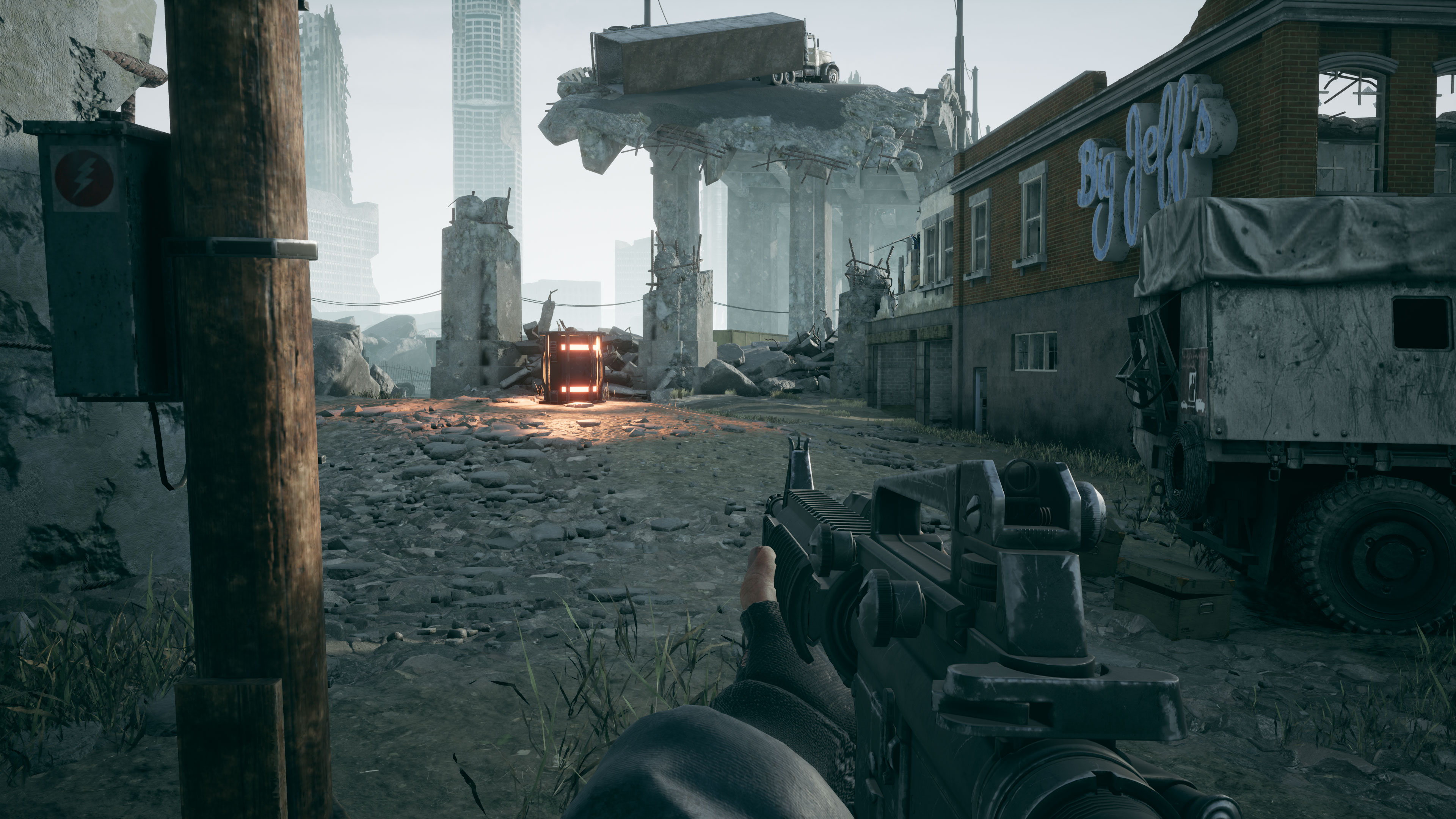
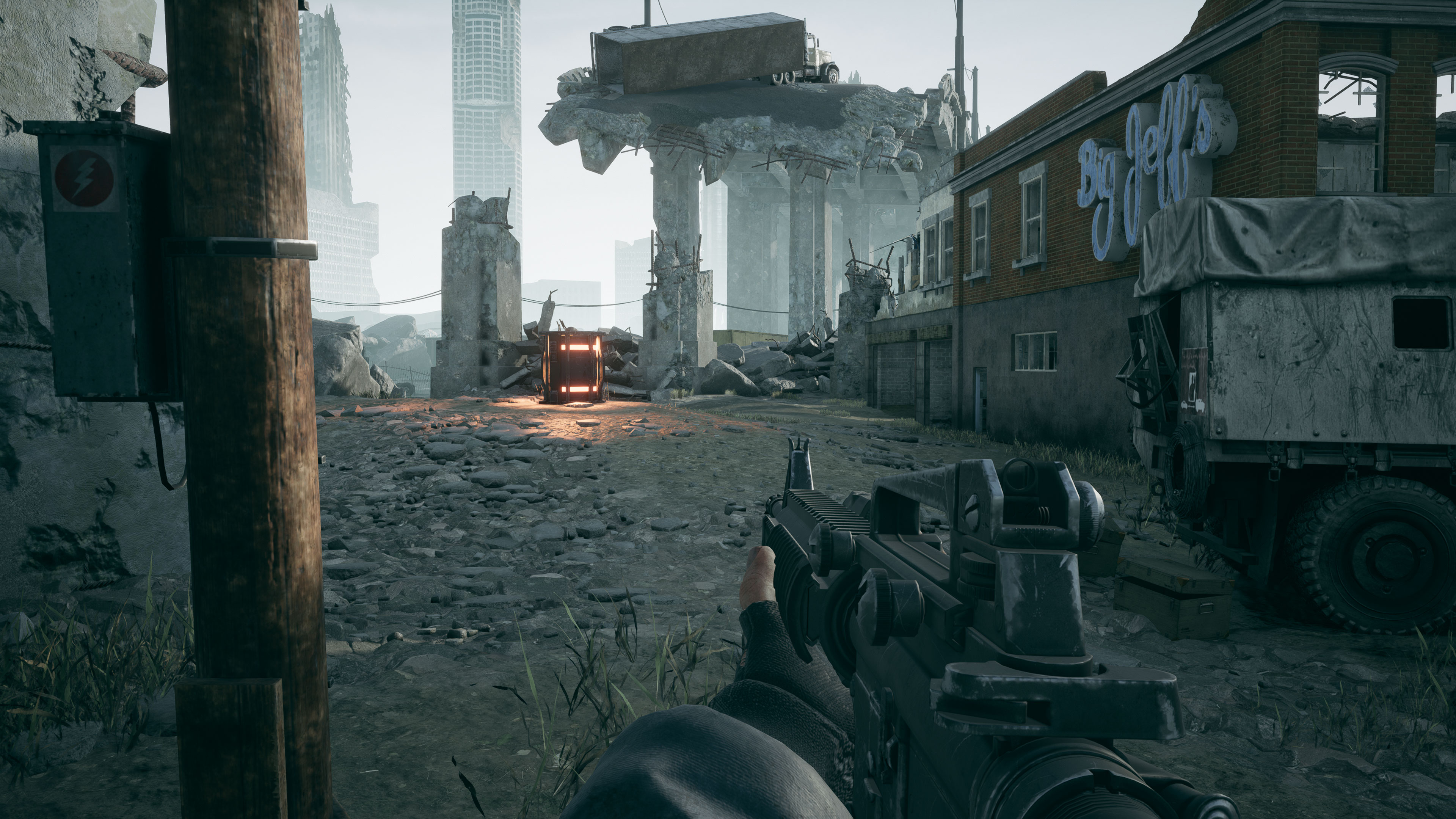
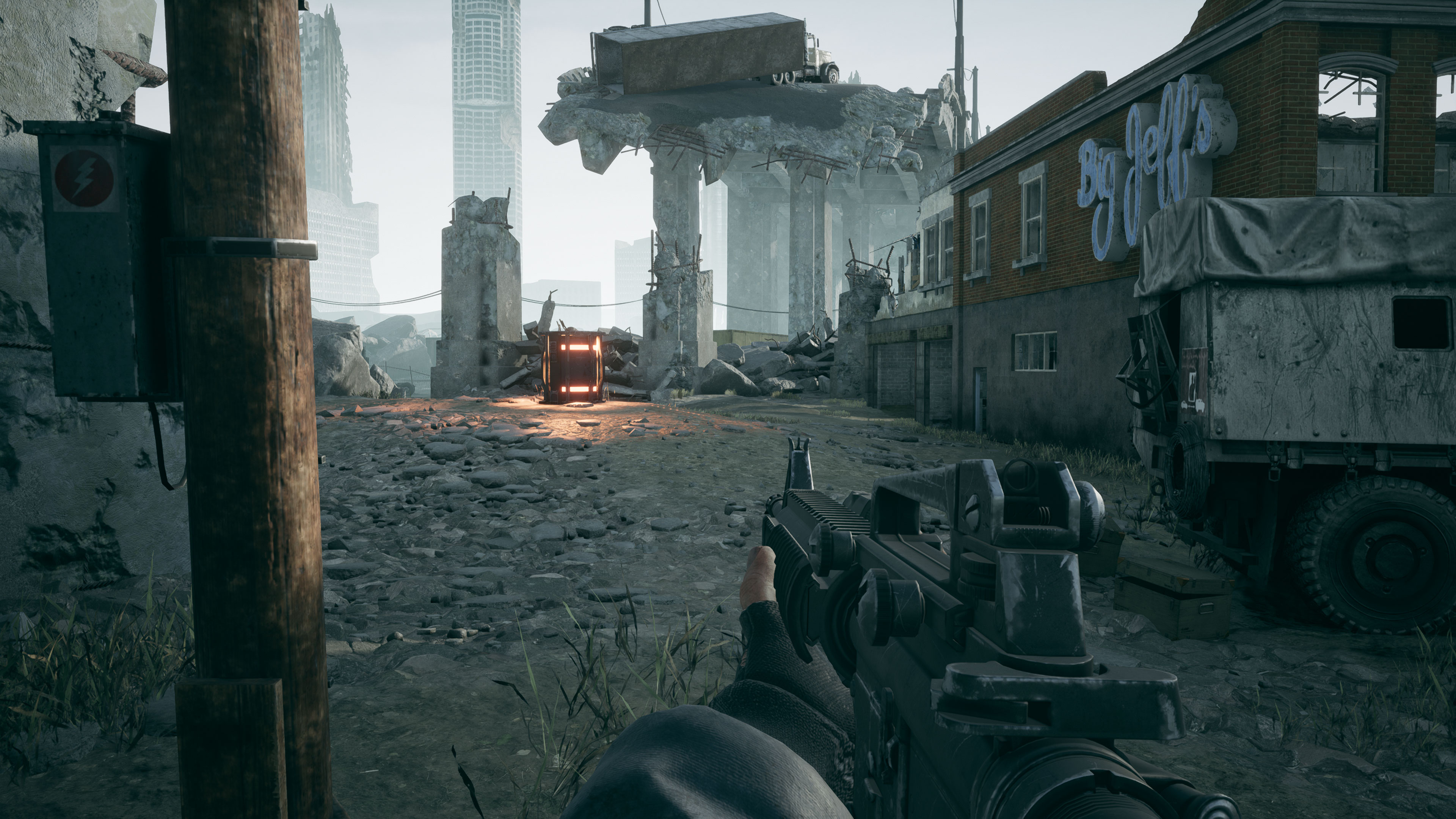
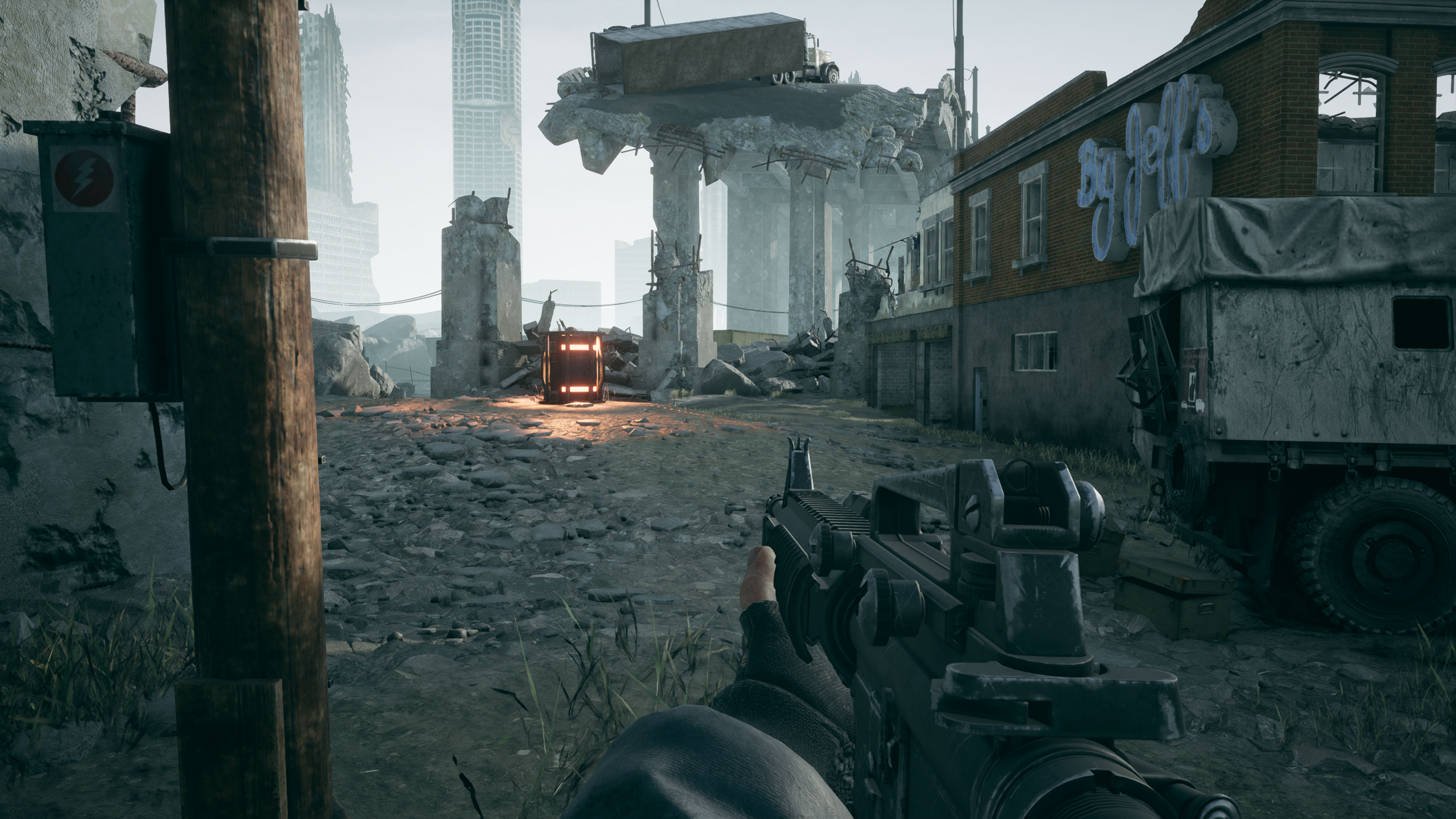
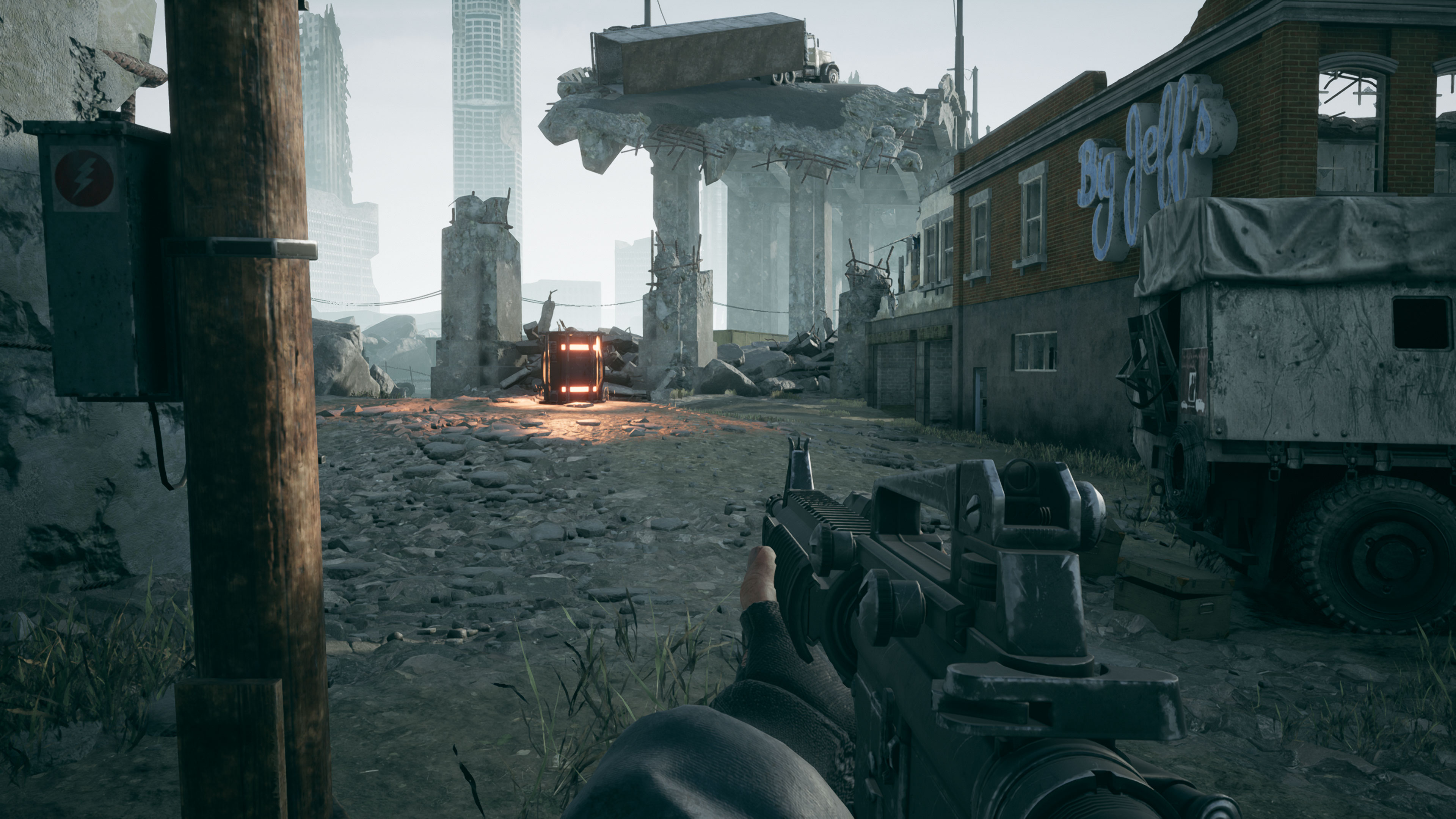
In Ultra Quality mode, AMD promises image quality that’s "indistinguishable from the target native resolution when viewed from normal gaming viewing distances." Our testing found it looked very similar to the game being rendered at its native resolution and occasionally better in some scenes.
Quality mode is said to offer image quality that’s "representative of native rendering while delivering great performance." While not as much so as Ultra Quality mode, our testing also found Quality mode to look close to native rendering.
Balanced mode creates an image "approximating native rendering quality." The more upscaling, the more noticeable visual artifacts become, and during our testing, we found that Balanced requires a compromise. However, in motion the loss in image quality tends to be less noticeable than when standing still.
Performance mode, AMD admits, "visibly impacts image quality and should only be selected in situations where the need for the ultimate in performance is critical." As you'd expect, upscaling using one fourth of the target resolutions pixels can be a bit hit and miss.
Your choice of GPU will also affect what sort of performance gains you can expect. We haven’t confirmed all of AMD’s numbers below, but the numbers it shared for Terminator: Resistance and Godfall were in line with what we saw in our own testing.
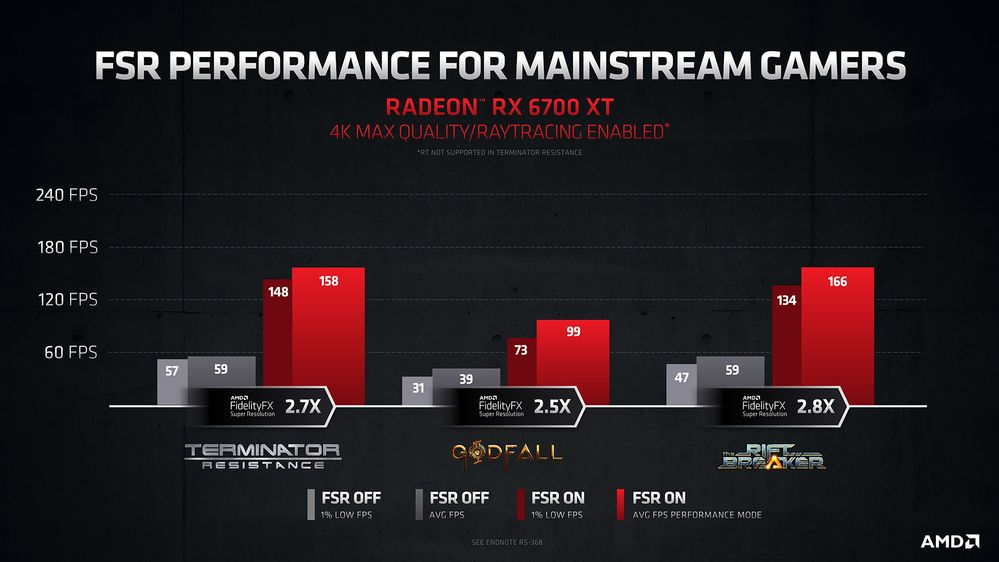
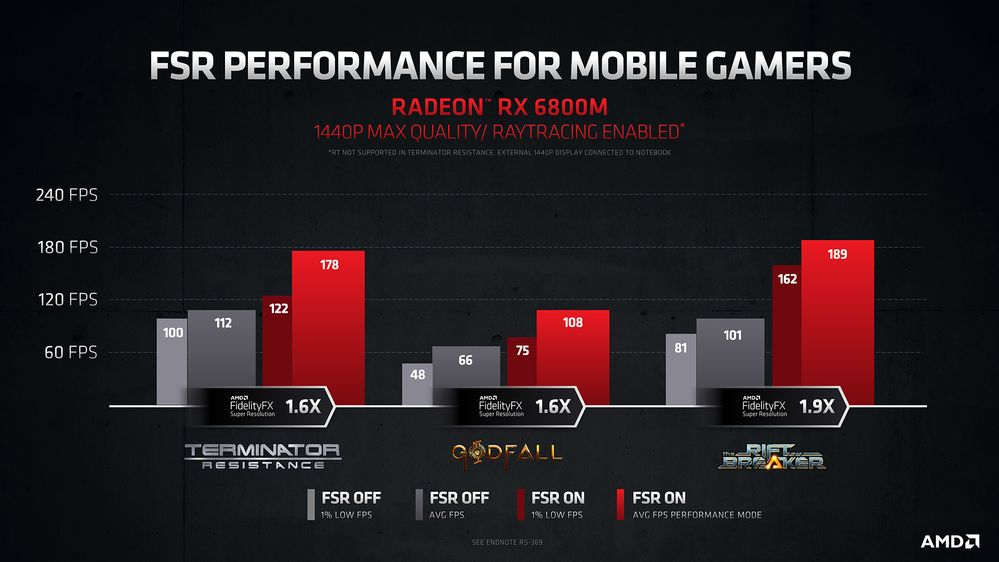

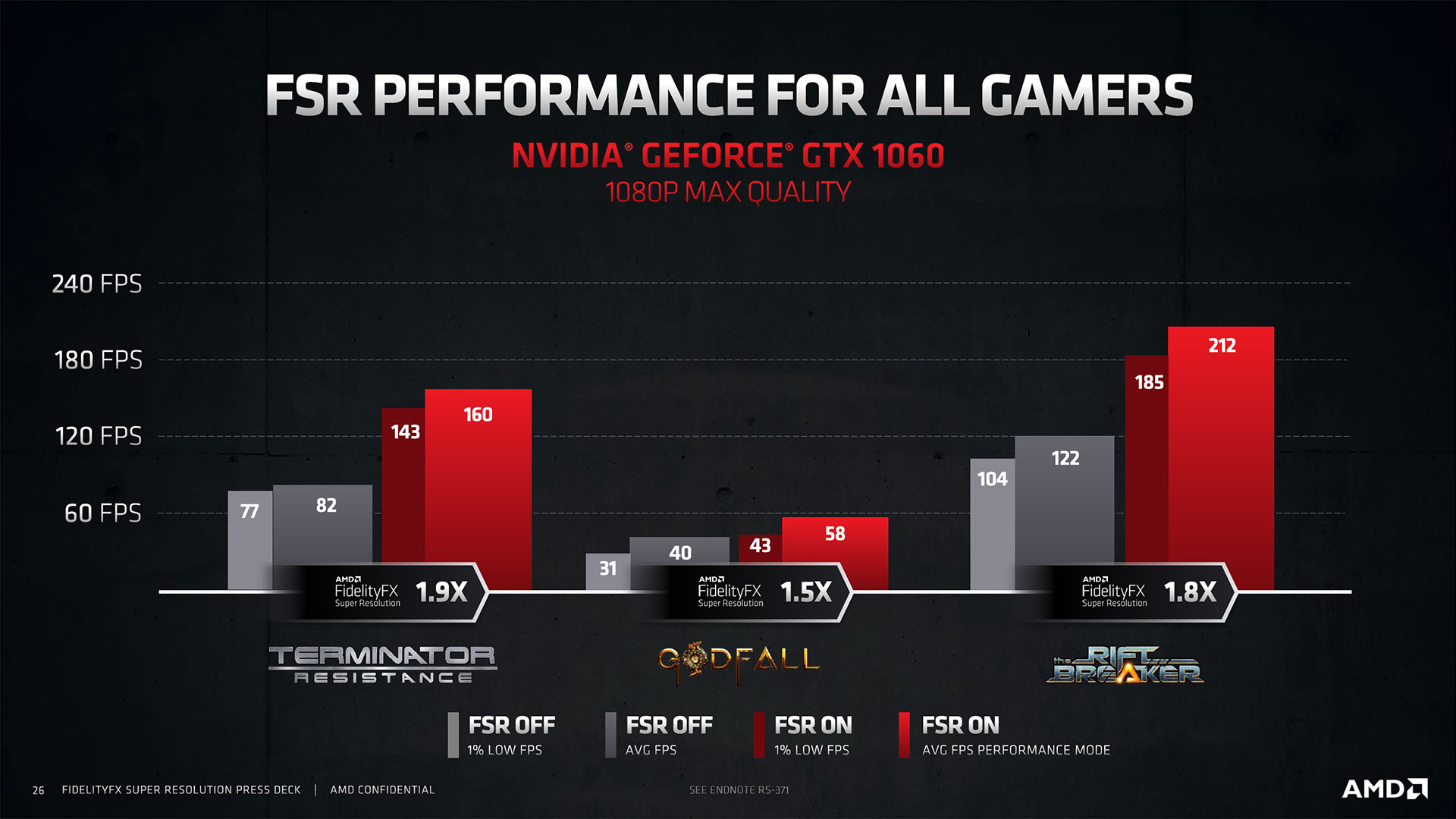
This article is part of the Tom's Hardware Glossary.
Further reading:
- Investigating AMD's FidelityFX Super Resolution Performance and Image Quality
- Best Graphics Cards
- GPU Benchmarks and Hierarchy

Scharon Harding has over a decade of experience reporting on technology with a special affinity for gaming peripherals (especially monitors), laptops, and virtual reality. Previously, she covered business technology, including hardware, software, cyber security, cloud, and other IT happenings, at Channelnomics, with bylines at CRN UK.
-
hannibal Well this definitely make 4K gaming more possible!Reply
I use 4K monitor to get sharper text and image in normal workloads, but I also play sometimes and 4K is still very demanding for gpus. This will allow 4K gaming with reasonable priced gpus, so very promising feature. Also it seems that FSR is better at higher resolution, when low res versions leaves too little info to make sharp enough graphic for the games. -
husker So then how does this work in conjunction with FreeSync? Say I have a 144Hz FreeSync monitor. Will FreeSync and FidelityFX cooperate to give me a smoth 144 FPS experience, or will they each do their own thing and let whatever happens happen? It seems to me that there is an opportunity for some kind of benefit or efficiency here, but I don't know enough to put my finger on it.Reply -
hotaru.hino Reply
FSR is part of the rendering process, it's no different than if you added, for example, Sonic Ether's shader mods.husker said:So then how does this work in conjunction with FreeSync? Say I have a 144Hz FreeSync monitor. Will FreeSync and FidelityFX cooperate to give me a smoth 144 FPS experience, or will they each do their own thing and let whatever happens happen? It seems to me that there is an opportunity for some kind of benefit or efficiency here, but I don't know enough to put my finger on it.
EDIT: There's a slide that shows where it gets done:
-
husker I get that FSR is technically a separate technology from FreeSync and they are not directly related. But if I were an engineer or a manager at AMD I would say to myself, huh... there is an opportunity to make life easier and better for AMD customers by having the FSR software look to see if the user had a FreeSync monitor activated and then tune FSR to give the user the best possible image given the ideal FreeSync refresh rate for their monitor and GPU combination. Yes, a person with the right know how might be able to set that up manually, but then again they may not because it may require instantaneous "on the fly" adjustments that only software could make during actual gameplay due to the intensity of the scene and the given FPS at that moment. I'd expect AMD be able to make this happen behind the scenes. After all, their Ryzen CPUs and 6000 series GPUs work in concert using their Smart Access Memory feature. It may be marketing hype or it may be truly beneficial but at least they are giving us a reason to combine the two.Reply -
hotaru.hino Reply
What's an "ideal FreeSync refresh rate"?husker said:But if I were an engineer or a manager at AMD I would say to myself, huh... there is an opportunity to make life easier and better for AMD customers by having the FSR software look to see if the user had a FreeSync monitor activated and then tune FSR to give the user the best possible image given the ideal FreeSync refresh rate for their monitor and GPU combination.
Anyway, a better way of going about this if I'm understanding what you're trying to get at is setting a performance target and having the rendering engine adjust the quality/resolution/whatever settings on the fly to match try and match the performance target. Which is a thing in console games. It might be a thing in PC games but I'm not aware which ones if it is. -
SoNic67 Reply
What is not explained is how motion will affect this upscaling. All the examples are looking great when we are upscaling static pictures.Admin said:What’s the meaning of FidelityFX Super Resolution? AMD FSR explained.
What Is AMD FSR? FidelityFX Super Resolution Explained : Read more
FSR uses spatial upscaling using only the source image, while DLSS feeds a neural network through multiple inputs: the source image, motion vectors, temporal feedback from prior frames and the results of its training algorithm.
That's what makes the DLSS "special" - it maintains fidelity even during fast moving scenes, like the ones that happen all the time in games.
Static scenes don't need any upscaling technique, they can be rendered natively by any GPU, because even at 6-10 FPS will look great!
That would be the max refresh rate of that monitor. My monitor can do 42-60Hz FreeSync, but I really want to use 60 Hz in all the games. FreeSync/G-Sync was a round-about way of still playing a game at high resolution, on a system that is marginally adequate (rendering games at about 45-50FPS). FSR/DLSS do away with that, pushing all the framerates above that.husker said:ideal FreeSync refresh rate -
renz496 Replyhusker said:I get that FSR is technically a separate technology from FreeSync and they are not directly related. But if I were an engineer or a manager at AMD I would say to myself, huh... there is an opportunity to make life easier and better for AMD customers by having the FSR software look to see if the user had a FreeSync monitor activated and then tune FSR to give the user the best possible image given the ideal FreeSync refresh rate for their monitor and GPU combination. Yes, a person with the right know how might be able to set that up manually, but then again they may not because it may require instantaneous "on the fly" adjustments that only software could make during actual gameplay due to the intensity of the scene and the given FPS at that moment. I'd expect AMD be able to make this happen behind the scenes. After all, their Ryzen CPUs and 6000 series GPUs work in concert using their Smart Access Memory feature. It may be marketing hype or it may be truly beneficial but at least they are giving us a reason to combine the two.
i dare to bet AMD will not want to spend extra resource to make such complicated tech. -
thanny Reply
That's already possible. Any game which uses variable shading to maintain a specified performance level can use FSR as well to make the lower-resolution portions look better. The tools are there for a game to do exactly what you describe.husker said:I get that FSR is technically a separate technology from FreeSync and they are not directly related. But if I were an engineer or a manager at AMD I would say to myself, huh... there is an opportunity to make life easier and better for AMD customers by having the FSR software look to see if the user had a FreeSync monitor activated and then tune FSR to give the user the best possible image given the ideal FreeSync refresh rate for their monitor and GPU combination. Yes, a person with the right know how might be able to set that up manually, but then again they may not because it may require instantaneous "on the fly" adjustments that only software could make during actual gameplay due to the intensity of the scene and the given FPS at that moment. I'd expect AMD be able to make this happen behind the scenes. After all, their Ryzen CPUs and 6000 series GPUs work in concert using their Smart Access Memory feature. It may be marketing hype or it may be truly beneficial but at least they are giving us a reason to combine the two.
